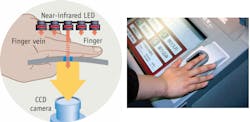Vein scanning personalizes everything from cars to gym equipment
“At your fingertips” takes on a whole new meaning with Hitachi Information and Control Solutions’ (Tokyo, Japan) finger-vein scanning authentication device. Imagine being able to unlock your car, adjust the seats and mirrors, and even start the engine, all with a single touch of an index finger. Better yet, access your money at the ATM, pay for your food at your favorite drive-through restaurant, and download music for your car stereo system—all with the touch of a finger.
Biometric identification methods such as fingerprinting, voice authentication, face recognition, and iris scanning all have pros and cons in terms of their ease of use and level of security. Near-IR vein scanning (also known as vascular patterning) has emerged as a more-secure biometric method that improves authentication speed and false-rejection/acceptance rates. Fujitsu (Tokyo, Japan) was the first to market with its palm vein-scanning technology (2004); Bionics America (Los Angeles, CA) and Hitachi (Tokyo) have focused on developing and commercializing finger-vein scanning; and TechSphere (Seoul, Korea), through its Canadian partner Identica (Toronto, Canada), has the corner on back-of-the-hand vein scanning.
According to Hitachi, unlike other forms of biometrics, which obtain information from external parts of the body, vein-authentication scans the interior of the body, making forgery extremely difficult. It is also less expensive than iris scanning and face/voice recognition, and the false rejection rate is significantly lower than fingerprinting.
Hitachi’s finger-vein authentication device uses infrared LEDs and a CCD camera to scan and image the vein pattern in each finger, comparing it to the database associated with the application assigned to that finger. When a finger is placed on the Hitachi device, near-IR light is transmitted through the skin and partially absorbed by hemoglobin in the blood without interference from wrinkles, lines, roughness, dryness, or other imperfections on the surface (see figure). The veins appear as shadows or dark areas in the CCD image. Using a proprietary image-processing algorithm, the image is then transformed into a high-contrast vein-pattern profile that is compressed and digitized so it can be registered as a template of a person’s biometric data.
Hitachi is initially targeting door/building access, computers, and ATMs. The company also sees great potential in the automotive market. In 2005, Hitachi introduced a grip-type finger-vein authentication capability that enabled a car door to be opened simply by grasping the handle. Other potential automotive applications include adjusting seats, air conditioners, and mirrors; preventing car theft through personalized door locks and ignitions; and authorizing automatic in-vehicle payment for food at a drive-through or for music downloads for a car audio system. Multiple applications with a single device are possible because each finger on a person’s hand could be used to authorize a different transaction or event.
Even more-personalized applications are emerging. Earlier this year Fukui Computer (Fukui, Japan) unveiled a line of networked exercise machines equipped with Hitachi finger-vein readers. When users identify themselves with a simple press of the finger, the machines respond by automatically adjusting the weight resistance and seat position based on the user’s previously set preferences. The machines also connect to a remote server to retrieve the user’s personal exercise data—including previous exercise records and stats, training regimens, and calorie consumption data.
Just what we need—another reminder of how long it’s been since the last workout.
About the Author
Kathy Kincade
Contributing Editor
Kathy Kincade is the founding editor of BioOptics World and a veteran reporter on optical technologies for biomedicine. She also served as the editor-in-chief of DrBicuspid.com, a web portal for dental professionals.
